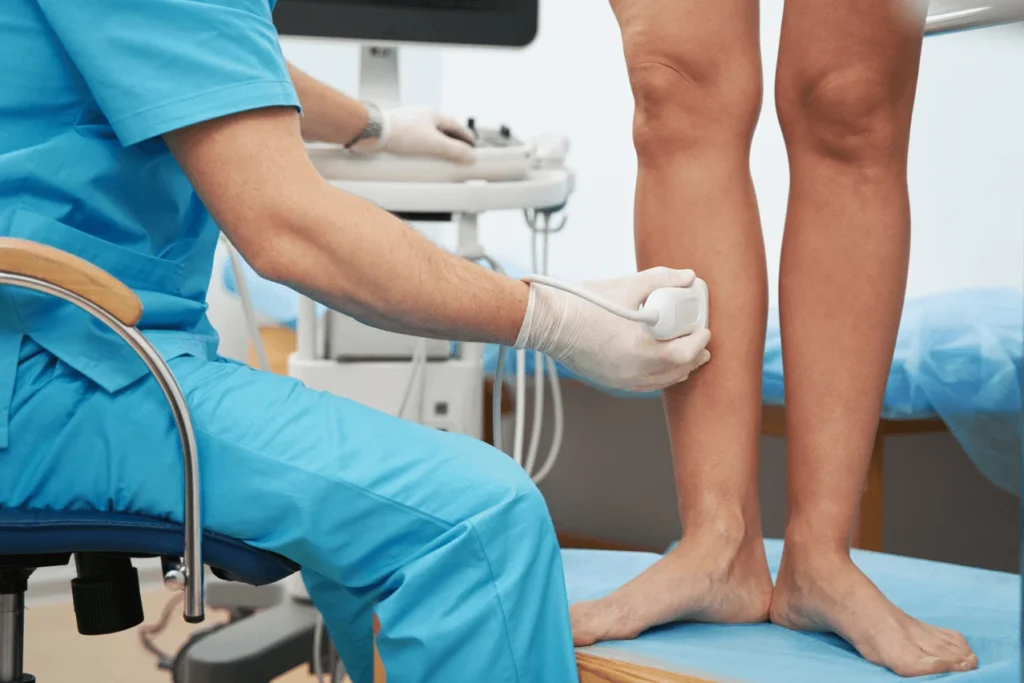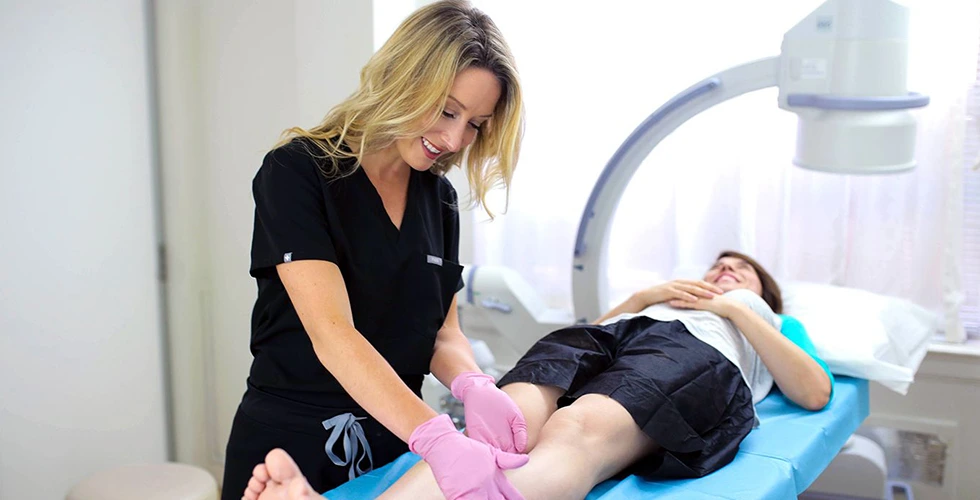Varicose veins and spider veins affect millions of people around the world. While varicose veins are particularly common among women and older individuals, they can happen to just about anyone. And your risk of getting varicose veins is particularly high if you’re genetically predisposed to the condition, i.e., if your parents have a history of spider veins, varicose veins, chronic venous insufficiency, and other vein conditions.
There’s a misconception that spider veins and varicose veins are purely cosmetic issues. As experts in vein care, we’re here to bust that myth. Spider veins aren’t inherently harmful, and varicose veins aren’t particularly dangerous in the initial stages, but they’re serious problems that you must deal with promptly. Even though spider veins aren’t harmful in their own rights, they’re often symptomatic of chronic venous insufficiency. And varicose veins are almost always caused by vein disease, and the longer they go untreated, the worse the symptoms become.
Untreated varicose veins can eventually lead to leg ulceration, deep vein thrombosis, and numerous problems. So yes, it’s terrible to leave varicose veins untreated, especially when the treatment is so accessible and easy! Maryland Vein Clinic is led by board-certified vein doctors who specialize in diagnosing and treating the root cause of varicose veins. We only offer minimally invasive varicose vein treatments that conclude within an hour, cause minimal discomfort, and allow you to resume daily activities immediately.
You can find our vein clinic in Maryland at 10215 Fernwood Rd, Suite 301, Bethesda. So what are you waiting for? Schedule an appointment our vein clinic in Maryland and do something about your varicose veins before you suffer unwanted consequences.

1. Leg Swelling
Leg swelling is a common consequence of untreated varicose veins and vein disease. When the valves in your veins malfunction, blood pools in the affected veins, increasing pressure. Over time, the continued accumulation of blood in leg veins leads to leg swelling. This can cause considerable discomfort and make it hard for you to walk comfortably or even perform basic daily activities. The only way to solve this issue is to treat varicose veins and restore optimal blood flow to the heart.
2. Pain & Discomfort
Varicose veins and vein disease often bring about persistent pain and discomfort. When your varicose veins expand, they start exerting pressure on the surrounding tissues, including other blood vessels and nerves. This signals to your nerves that you are in pain, leading to increasing discomfort. Furthermore, just the weight of the enlarged veins and accumulated blood can lead to feelings of leg heaviness, which prevents you from performing daily activities.
3. Skin Changes & Ulcers
Untreated varicose veins and vein disease can trigger noticeable skin changes and, in severe cases, ulcers. Leg ulcers are basically wounds that refuse to heal naturally. Normally, when you’re injured, blood rushes to the site of injury to heal the problem. But when you’re suffering from chronic venous insufficiency, blood flow to the legs is interrupted. As such, the wounds don’t get the regenerative treatment they need to heal naturally. This leads to chronic ulceration, which can also lead to several other complications and infections.
4. Blood Clots & Deep Vein Thrombosis (DVT)
Untreated varicose veins can lead to a heightened risk of blood clot formation, specifically deep vein thrombosis (DVT). Weak blood flow in varicose veins can encourage the development of clots within these malfunctioning blood vessels. If a clot dislodges and travels through the bloodstream, it may reach deeper veins, causing DVT. This is perhaps one of the most dangerous complications of varicose veins and untreated vein disease. If the blood clots break away, they may travel to the lungs, leading to a potentially fatal condition known as pulmonary embolism. As such, you must prevent vein disease from reaching this stage.
5. Superficial Thrombophlebitis
Superficial thrombophlebitis is the formation of blood clots in superficial veins just beneath the skin’s surface. This occurs when these veins become inflamed and blood flow slows down, often due to untreated varicose veins. When there isn’t enough blood flow, blood clots can develop in the veins, leading to further circulation problems. This can lead to redness, leg pain, leg heaviness, warmth sensations, and other issues. While it’s not as bad as deep vein thrombosis, it can eventually get worse and requires medical treatment.
6. Profuse Bleeding
Untreated varicose veins can make the veins near the skin’s surface fragile and prone to injury. You can think of the vein as a balloon — the more it expands with blood, the weaker its walls become. Eventually, you get to a point where even a minor bump or scratch can lead to burst varicose veins. This occurs because the weakened vein walls are less able to withstand pressure, resulting in significant bleeding. Profuse bleeding from varicose veins necessitates immediate medical attention to control bleeding.
7. Restless Leg Syndrome (RLS)
Restless Leg Syndrome (RLS) is a neurological disorder that makes you want to shake and move your legs all the time. You may also have sensations of tingling, itching, and crawling on your skin, which can be extremely uncomfortable and painful. Untreated varicose veins can contribute to RLS due to the disrupted blood flow in the affected legs. Most people with restless legs have trouble sleeping because their legs are constantly shaking, which can lead to insomnia and other issues. RLS can dramatically affect your overall quality of life.
8. Cellulitis
Cellulitis is a bacterial skin infection that occurs when certain unwanted bacteria enter your body through open wounds. As we discussed previously, untreated varicose veins can lead to leg ulcers, thus creating the perfect environment for bacteria and viruses to infiltrate your body. Since the skin is damaged and weakened, bacteria can easily enter. And since blood doesn’t flow readily to the legs, your immune system isn’t able to fight them off. As a result, you have to deal with redness, swelling, pain, infection, and other complications requiring treatment.
9. Venous Stasis Dermatitis
Venous Stasis Dermatitis is a dermatological condition wherein the lack of blood circulation to the legs leads to the accumulation of waster and fluids in your tissues. Over time, the accumulated waste can negatively affect your skin, leading to thickening of the skin, inflammation, and other painful symptoms. This condition can also weaken your skin, making it more fragile and increasing the risk of cuts and bruises. And as we mentioned before, when you get cuts and bruises, they’re less likely to heal, leading to ulcers, which can lead to infections.
10. Impact on Quality of Life
Varicose veins can negatively affect your life in more ways than you can imagine. Because of the medical complications associated with varicose veins, you can suffer from a wide range of health problems that make life challenging. But even in the early stages of varicose veins, you may suffer considerable self-consciousness because of the ugly appearance of twisted, knotted, gnarled veins. Some patients with varicose veins even suffer from mental health issues and isolation because they gradually stop attending social events that may necessitate wearing dresses or shorts. Varicose veins can affect your life in every possible way.
Preventing Varicose Veins and Reducing Risk
There are no obvious ways to prevent varicose veins. That’s because varicose veins can occur because of a wide range of reasons, such as genetic predisposition, pregnancy, and other factors that can damage vein valves. However, while you can’t prevent varicose veins altogether, you can take steps to minimize their risk.
The following lifestyle changes can reduce the risk of varicose veins and vein disease:
- Stay Active: Engaging in regular physical activity can help improve circulation in your legs. Simple exercises like walking or cycling can make a significant difference.
- Maintain a Healthy Weight: Being overweight or obese can increase the risk of varicose veins. Maintaining a healthy weight through diet and exercise can lower this risk.
- Elevate Your Legs: Whenever possible, elevate your legs above the level of your heart. This can help reduce swelling and improve blood flow.
- Avoid Prolonged Sitting or Standing: If your job requires prolonged periods of sitting or standing, take breaks to move around and stretch your legs.
- Wear Compression Stockings: Compression stockings apply pressure on your veins to push blood forward. Consult our vein specialists to identify the right compression stockings.
- Healthy Diet: A diet rich in fiber and low in salt can help prevent constipation and reduce the risk of developing varicose veins. This contributes to maintaining a healthy weight.
Maryland Vein Clinic is led by highly-skilled board-certified vein doctors who can guide you in treating varicose veins at the earliest stage possible. Our vein doctors always perform thorough diagnostic tests to identify the root cause of varicose veins, following which they offer minimally invasive treatments. You can find our vein clinic in Maryland in Silver Spring. Please schedule an appointment to treat your varicose veins at the earliest stage possible.





